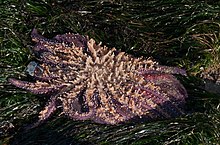Sunflower sea star
| Sunflower sea star | |
|---|---|

| |
| Scientific classification | |
| Kingdom: | |
| Phylum: | |
| Class: | |
| Order: | |
| Family: | |
| Genus: | Pycnopodia
|
| Species: | P. helianthoides
|
| Binomial name | |
| Pycnopodia helianthoides | |
Pycnopodia helianthoides, commonly known as the sunflower sea star, is a large sea star found in the northeast Pacific. It is among the largest sea stars in the world (but not quite the largest), with a maximum arm span of 1 m (3.3 ft). Sunflower sea stars usually have 16 to 24 limbs; their color can vary widely. They are predatory, feeding mostly on sea urchins, clams, snails, and other small invertebrates.
Description

Sunflower sea stars can grow to have an arm span of 1 m (3.3 ft) in diameter.[2] Their color ranges from bright orange, yellow and red to brown and sometimes to purple, with soft, velvet-textured bodies and 16 to 24 arms with powerful suckers.[2][3] Most sea star species have a mesh-like skeleton to protect their internal organs.[4]
Distribution and habitat
Sunflower sea stars are common in the northeast Pacific from Alaska to Southern California,[2] and are largest in Puget Sound, British Columbia and Alaska.[4] They generally inhabit low subtidal and intertidal areas rich in seaweed[5] or kelp.[6] They do not venture into high- and mid-tide areas because their body structure is fleshy and requires water to support it.[7]
Diet
Sunflower sea stars are quick, efficient hunters, moving at a speed of 1 m/min (3.3 ft/min) using 15,000 tube feet which lie on the undersides of their bodies.[2][3] They are commonly found around urchin barrens, as the sea urchin is a favorite food. They also eat clams, snails, abalone, sea cucumbers and other sea stars.[2] In Monterey Bay, California, they will feed on dead or dying squid.[8] Although the sunflower sea star can greatly extend its mouth, for larger prey, the stomach can extend outside the mouth to digest prey, such as gastropods like abalone.[9]
Easily stressed by predators such as large fish and other sea stars, they can shed arms to escape, which will grow back within a few weeks. They are preyed upon by the king crab.[4]

Reproduction
Sunflower sea stars can reproduce either asexually through fissiparity or sexually through broadcast spawning.[10] They also have separate sexes.[9] Sunflower sea stars breed from May through June. In preparing to spawn, they arch up using a dozen or so arms to hoist their fleshy central mass free of the seafloor and release gametes into the water for external fertilization.[9] The microscopic sea star larvae float and feed near the surface for 2 to 10 weeks. After the planktonic larval period, the larvae settle to the bottom and transform into juveniles.[4] Juvenile sunflower sea stars begin life with five arms, and grow the rest as they mature.[8] The lifespans of most sunflower sea stars is three to five years.
References
- ^ "Pycnopodia helianthoides". Integrated Taxonomic Information System. Retrieved 9 April 2007.
- ^ a b c d e Sunflower sea star - NOAA
- ^ a b Telnack, Jennifer. Intertidal Marine Invertebrates of the South Puget Sound, NW Marine Life.
- ^ a b c d Sunflowerstar. Scott Boyd's Emerald Sea Photography.
- ^ North Coast Intertidal Guide: Seastars & Urchins, Humboldt State University. Arcata, CA.
- ^ Sunflower Star. Channel Islands National Park. National Park Service.
- ^ Sunflower Star. North Island Explorer.
- ^ a b Monterey Bay Aquarium: Online Field Guide - Sunflower star. Monterey Bay Aquarium.
- ^ a b c Sea stars and relatives, Edmonds Discovery Programs, City of Edmonds, Washington.
- ^ Aaron Shepard. "Pycnopodia helianthoides, The Sunflower Star". Evergreen State College. Retrieved 28 February 2012.
External links
- Sunflower sea star - NOAA
- Byrnes, Jarrett. "Sunflower Stars: Rulers of the Reef". deepseanews.com.
